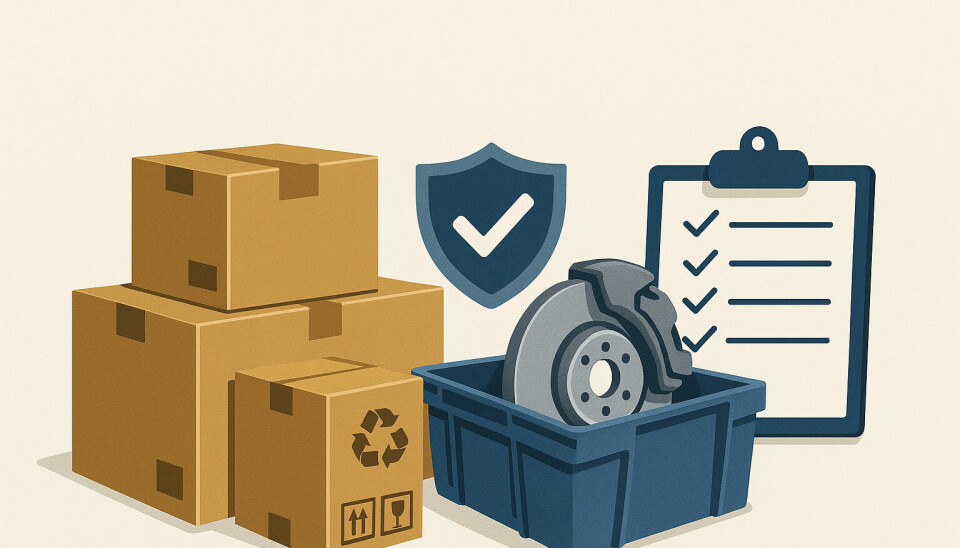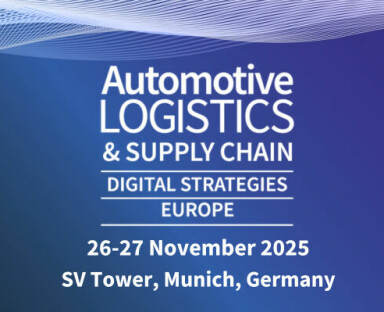Lean logistics, sustainability and compliance
From packaging regulation to innovation: How automotive logistics is rethinking packaging

With new regulation around packaging set to transform every step of the supply chain, from inbound parts to aftermarket service flows, the automotive industry is paying closer attention to an often overlooked aspect of the supply chain, packaging.
Industry leaders at the Odette 2025 conference shared practical strategies, collaborative projects and innovative technologies aimed at meeting the new requirements while unlocking operational and environmental benefits.
Understanding the EU’s new packaging regulations, and why action is needed now
The EU’s Packaging and Packaging Waste Regulation (PPWR) aims to improve sustainability by setting the minimum recycled content targets for packaging at 30% by 2030 and 65% by 2040.
Dr Sarah Faltaous, industrial solution consultant at MHP, an IT consulting subsidiary of Porsche, outlined what the automotive industry needs to do now to prepare for the regulation’s sweeping scope. She said that the PPWR, which replaces the older directive with a binding regulation, introduces mandatory recyclability grades, digital tracking and product passports, extended producer responsibility and penalties for non-compliance. It applies to any material used to “contain, handle, protect and deliver products,” whether business-to-business or business-to-consumer.
The digital product passport will be a key part of this for companies in automotive logistics. “The idea is to have a centralised database that has all the data behind the product, and part of that is the packaging material,” she said.
By 2030, packaging without at least a performance grade of C will be banned from the EU market, with interim targets for labelling, weight/volume minimisation and reuse phased in between 2026 and 2028.
Faltaous urged the automotive sector to take immediate steps. “This should not be taken lightly or in the sense of ‘let’s wait and see’,” she said. “Do anything but wait. Start at any point you want, but there is no time to wait, especially in the automotive industry. We know that it takes a lot of time to ideate about the system, implement it and then convince people and get it to be working. My approach that I would recommend is to start with the first step of assessing what you need to change.”
She said OEMs and logistics firms should start with a comprehensive packaging assessment, looking at who is responsible for what under regulations, and whether any steps have already been taken to develop packaging processes in line with the new regulations. From there, map responsibilities across the supply chain while monitoring evolving guidance from the European Commission, and identify efficiency gains that go beyond compliance.
“Having done that, I would move to the second step, and try to define a compliance framework and a map of what needs to change and when. We need to have a clear timeline,” she said. “Some packaging has been in the industry for eight, nine, 10 years, maybe even 20. Who was responsible for all the documentation?”
Following that, board buy in is the next step, she said. “Management needs to understand the need for change,” said Faltaous, adding that investment might be needed in rectifying or improving packaging solutions.
Then, communicate with the wider global supply chain on rules and regulations being enforced, to ensure the most efficiency and standardisation as possible. “There are some rules and regulations on the national level. France has its own, and Germany, Spain and Italy have their own. How do they contradict or come together with the PPWR? That’s still a very open question,” she said.
Investment costs versus savings and logistics optimisation
The EU estimated that the new regulations would cost around €9.4bn in a briefing published in 2022, but estimated that the benefit would be worth €50bn in the long-term. While this is a big upfront cost for OEMs, suppliers and logistics firms, Faltaous said that the investment can be used to help optimise logistics, too.
“Couldn’t we just use this packaging minimisation to also optimise transportation processes? That would save costs, and this is the time to do that,” she said. “Do not wait until the regulation is there and then you’re either fined or banning products.”
This is something that several OEMs have been implementing, including BMW, which improved efficiency at BMW Dingolfing with AI-powered packaging and container management.
Stellantis: Turning circular economy principles into packaging practice
For Marco Cioffi, supply chain global packaging at Stellantis, the need to act is urgent. “What we will measure in 2030 is something we are going to design tomorrow,” he said. “We have to be prepared.”
Stellantis has already been implementing its packaging strategy, and as a result, the OEM has seen a 2-3% overall optimisation on transport globally, according to Cioffi.
Stellantis’ short-term strategy focuses on avoiding waste before it happens through reduction and reuse. Reduction measures include removing unnecessary protective layers after quality reviews, increasing packaging density through part reorientation and design adjustments, and using foldable or nestable packaging to cut the volume of empty returns.
The company’s innovation projects demonstrate how circular economy thinking is being applied to real-world challenges. Examples include plastic containers with 60% recycled content, fully recycled cardboard interlayers with improved cushioning, and nestable trays designed for battery modules, a fast-growing category in the EV era.
Reuse extends beyond closed loops between suppliers and plants. Overseas pallets, for example, are repurposed for different commodities before final disposal, and maintenance and repair extend the life of returnable assets.
But he added that long-term thinking is needed, too, which means investing in new tools. “We are working internally to develop new tools to improve the level of analysis about our packaging,” he said. “We need to know all the details about packaging, about quantity, weight and material type, and this information today is not always available. We do not always manage these materials, but we still need to have these details.”
As a result, he stressed the need for data integration. “We need data interconnection,” he said. “Even if you have the best packaging system, it’s not enough. You need to understand the packaging system within the supply chain system.”
Collaborative standards: The Bosch–Audi industry packaging guideline
Katalin Elizondo-Ujlaky, corporate supply chain management logistics at Bosch, and leader of the VDA Packaging Standardisation Working Group, stressed the scale of the task. With each vehicle containing 15,000–30,000 parts, more than 1.6 trillion automotive components are shipped globally every year, each requiring packaging.
Complicating matters are geopolitical disruptions affecting raw material supply, including a shift in plastic production from China and the US to Vietnam, and a web of regulations. The PPWR is only one of around 10 major EU packaging laws, each layered with additional national rules.
But Elizondo-Ujlaky is optimistic about the regulation changes. “Like everything in life, you can see it as a threat or you can see it as a shift,” she says. “These regulations are forcing us to standardise and be more sustainable.”
To cut through the complexity, Elizondo-Ujlaky’s team worked with 48 companies, including closely with Audi, in 25 workshops to develop a cross-industry packaging guideline. The document, aligned with input from suppliers, customers, recyclers and packaging producers, sets out recommended and non-recommended materials for recyclability, optimisation tips for load efficiency and transport utilisation, standardisation measures for trays, pallets and strapping bands, and strategies to increase packaging density and reuse.
The aim is to harmonise approaches across the automotive supply chain, including aligning with packaging producers, the suppliers, the customers, and the recyclers.
She said that Bosch has been taking a similar approach to Porsche’s MHP, first evaluating its packaging, then defining and driving standardisation, and integrating software and data as a tool to help. She said that Bosche is working on a packaging data exchange platform, where data can be exchanged with suppliers and integrated into the supply chain to reduce time and effort and improve tracking and documentation.
“Take the legal requirements and optimise your packaging design and your processes, digitalise, standardise and cooperate,” she said. “Then, you will be compliant, you will be cost efficient, and you will be sustainable.”
Returnables as a primary lever for waste reduction
Robin Newing, returnable packaging operations leader for EMEA at digital solutions provider Cummins, said that packaging accounts for 33% of the company’s total waste footprint. He said that Cummins’ strategy is built around making returnable packaging a primary lever for waste reduction.
The approach rests on four pillars; track and trace, which involves implementing RFID-tagged, modular, adjustable packaging to manage pooling networks across multiple sites, intercompany optimisation and converting flows between company facilities to returnables before tackling external suppliers, supply base targeting focusing on high-cost freight lanes and geographical clusters to enable efficient return flows, and data-driven design, using freight cost and volume data to identify waste hotspots and guide conversion priorities.
“Most of the time when you hear about packaging is when it’s a problem. When it’s a problem, it’s too late, you’re already incurring damage,” he said.
Circular economy principles, industry-wide collaboration, and adoption of advanced tracking and data systems can deliver measurable savings.
To realise these benefits, automotive logistics must act now. That means designing for 2030 today, integrating packaging into broader supply chain strategies, and treating it not as an afterthought but as a driver of cost savings, emissions reduction and resilience.
Innovations and regulations in packaging will feature heavily at our upcoming Automotive Logistics & Supply Chain Global event in Plymouth, Michigan. We will host a special packaging focus, including strategies shared by directors of GM, Nissan and Magna International. Register now to secure your place!










